How is Turbidity Measured?
In general, measurement tools fit into three categories:
- Visual Tools require the user’s judgment to determine water clarity. Length units are used when reporting results (e.g., meters, feet).
- Turbidity Meters technically known as nephelometers – emit light and measure the amount scattered by particles in the sample. The units depend on the wavelength of the light and the angle of the detector(s)13; the most common units are Nephelometric Turbidity Units (NTU) or Formazin Nephelometric Units (FNU). Another term used for this type of instrument is a turbidimeter. These take the form of either a benchtop meter, continuous flow meter, or a submersible sensor (e.g., the YSI EXO or YSI ProDSS with a turbidity sensor).
- Spectrophotometers direct a beam of light at a specific wavelength through the sample. A detector determines the amount of light transmitted (i.e., the amount of light that doesn’t get scattered or absorbed). Depending on the light source, the units used are Attenuation Units (AU) or Formazin Attenuation Units (FAU).1 Since methods of turbidity measurement required by regulators require FNU or NTU, spectrophotometers are less common in the applications where turbidity is most commonly measured. Therefore, spectrophotometers are not discussed in more detail on this page.
Visual Tools
The Secchi Disk
The Secchi disk was invented by Pietro Angelo Secchi – an Italian Jesuit priest – in 1865 while serving as a scientific adviser to the Pope. He developed the disk that bears his name while quantifying water clarity in the Mediterranean Sea.14

The world’s first measurement of water clarity with a standardized tool – the Secchi disk – was taken in the Mediterranean Sea on April 20, 1865. Pietro Angelo Secchi was conducting an aquatic study while serving as one of the Pope’s scientific advisers.
The original Secchi disk featured an all-white, weighted circular disk. George C. Whipple modified the disk in 1899 for freshwater by adding alternating quadrants of black and white, as he believed it was easier to see than the marine version.15
Today, the black and white Secchi disk seems to be the most commonly used version, although some marine researchers still prefer a white disk.
The Secchi disk is used by lowering it through the water column until it is barely visible. The measurement recorded is the distance – in meters, feet, etc. – the disk was lowered into the water.
The advantage of using the Secchi disk is that it is low cost, portable, and easy to use. The primary disadvantage is that it relies on a person’s eyesight and proper lighting, resulting in potential issues with precision and accuracy.
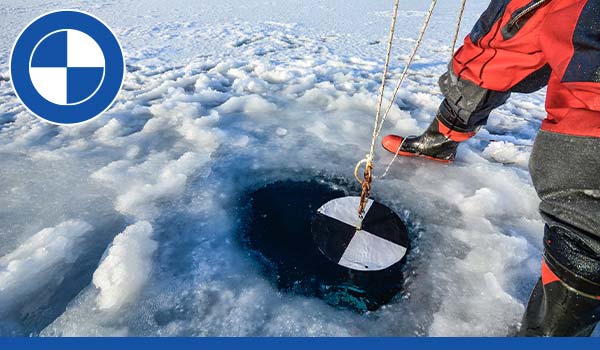
Secchi disks are the earliest and simplest form of turbidity measurement.
Transparency Tube
Another visual tool for the measurement of turbidity is a transparency tube. The tube is clear and features “hatch marks” to measure water depth. At the bottom, there is a stopper with a Secchi disk pattern and a release valve.
The transparency tube is filled with sample water. While looking down into the tube from the top, water is slowly released using the valve until the Secchi disk is barely visible. The remaining depth of water is then recorded. The procedure is typically performed at least twice, and an average value is recorded.
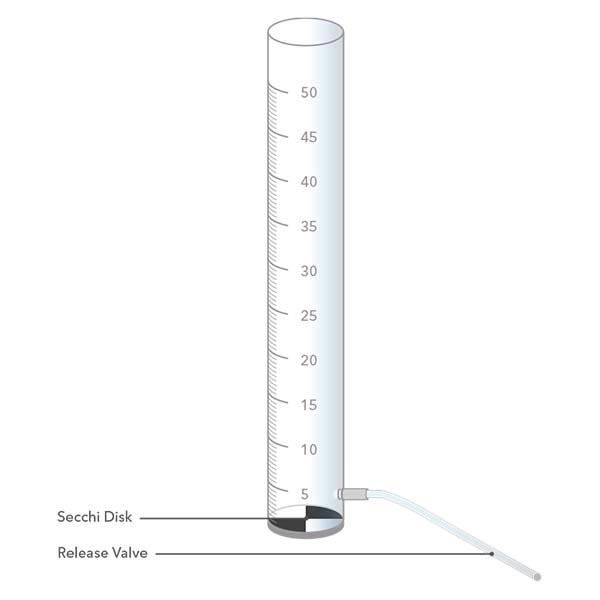
Transparency tubes are similar to Secchi disks, as they have a stopper at the bottom of the tube with a black and white pattern.
Transparency tube values are recorded in distance units, but tables are available for conversion to NTU. However, not all of these tables apply to every field condition – this is a significant drawback of transparency tubes.
Turbidity Meters (Nephelometers)
There are a variety of instruments that measure light scattered by particles in a sample. The differences between them are characterized by:
- Light Source
- Angle of the Detector(s)
- Whether they are Benchtop Meters, Continuous Flow Meters, or Submersible Sensors
Light Source
The two most commonly used light sources are 1) white light and 2) an 860 nm light (near IR). As discussed in the section on Turbidity Units, white light is specified by EPA Method 180.1, and the 860 nm light by ISO7027.
It should be noted that a laser is a third type of light source, but it is less common and will thus not be discussed in detail on this page.
White light is produced by an incandescent tungsten filament light bulb with a color temperature between 2,200 and 3,000 Kelvin. EPA Method 180.1 specifies a light wavelength that’s 400 to 680 nanometers.1
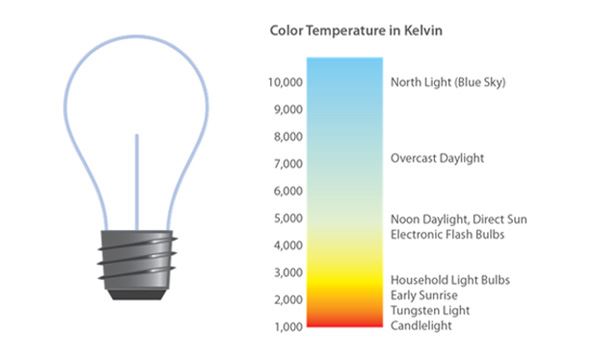
EPA Method 180.1 specifies the light source must be a tungsten lamp with a color temperature between 2,200 and 3,000 K.1
An 860 nm light (near IR) is used by turbidity sensors on instruments such as the YSI EXO and ProDSS. ISO7027 specifies the light source must be a light-emitting diode (LED) with a wavelength of 860 ± 60 nm.1
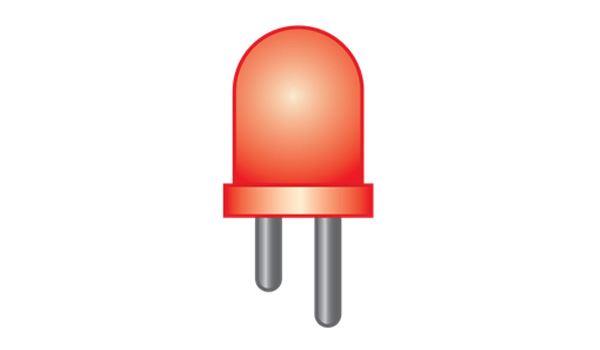
An LED light source – shown here – is specified by ISO7027.
The most obvious reason to select a particular light source is to comply with any regulations. For example, facilities in the United States that must report measurements to the EPA are likely required to use a white light source since it is compliant with EPA Method 180.1.
If you are not required to use a specific light source, there are some considerations to keep in mind when selecting which one to use.
Turbidity measurements are affected by particle size, particle density, and the color of water. A light source that follows ISO7027 eliminates the impact of color on the measurement and minimizes the effects of stray light. In contrast, white light detects smaller particles because it has a smaller wavelength.
Please refer to the section on How to Select the Right Turbidity Instrument for additional guidance regarding the best instrument for your application.
Angle of the Detector(s)
Once the light is emitted from the turbidity sensor, it is scattered by particles in the water. Sensors must have a detector to capture the amount of scatter or absorbance of the light. There are a variety of angles the detector – sometimes multiple detectors – can be placed.
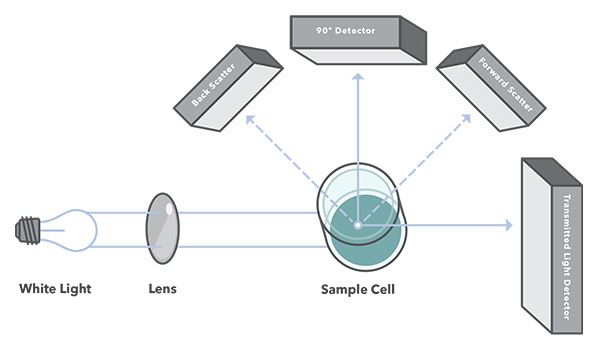
Detectors can be placed at various angles, with 90 degrees being the most commonly used.
A transmitted light detector – this is used by a spectrophotometer – detects all of the light transmitted by a light source except for what is scattered away by particulate matter. This type of detector is typically used in conjunction with a forward scatter detector, resulting in an accurate calculation of low turbidity values.
It is important to note that turbidimetry is technically the measurement of light transmitted through a sample (i.e., a transmitted light detector is used). In contrast, nephelometry measures the light that’s scattered away at an angle.16 However, the term ‘turbidimeter’ is still commonly used to describe instruments that detect scattered light at an angle.
A backscatter detector is typically used when turbidity levels are very high – such as in wastewater treatment – as the decreased light path length allows for reception of more scattered light than any other angle. Backscatter detectors should not be used if the turbidity is expected to be less than 1000 FNU. TSS sensors like the YSI IQ SensorNet ViSolid use a backscatter detector.
The most common angle is 90 degrees from the light source, and this is the angle specified by both EPA Method 180.1 and ISO7027.
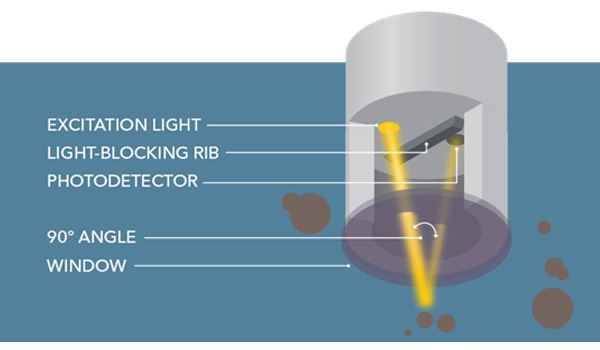
Ninety degrees is the most common angle used by turbidity meters, including YSI submersible turbidity sensors.
We mentioned earlier that nephelometry measures the light scattered away at an angle.16To be more specific, the United States Environmental Protection Agency (EPA) defines nephelometry as the measurement of light scattering using a light detector 90 degrees from the incident light.1
So, what’s so special about 90 degrees? It’s all about how light scatters when it contacts particles of different sizes.
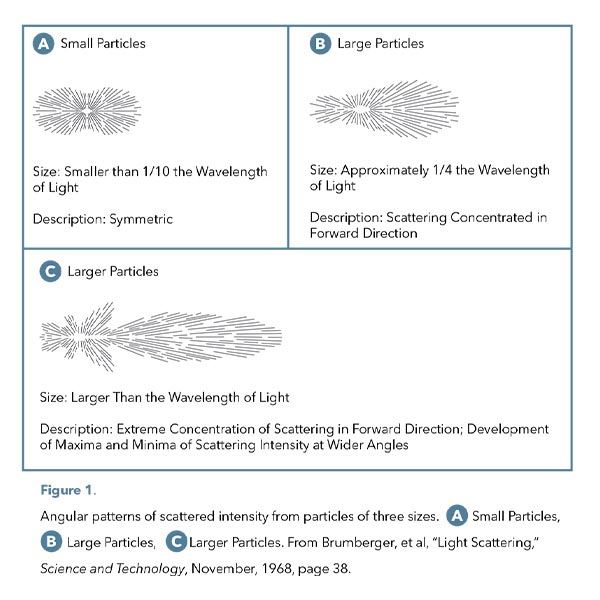
Regardless of particle size, light scatter patterns remain relatively consistent and are minimized at a 90-degree angle.
Small particles produce a symmetrical, peanut-shaped light scatter pattern when light is transmitted through a sample. The particle interference is minimized at 90 degrees.
As particle sizes become larger, the scattering intensity significantly increases, but the scattering intensity is still minimized at a 90-degree angle from the incident light beam source.
In summary, at 90 degrees, there is less interference than at other angles. Also, the longer the distance the light source has to travel, the more accurate the turbidity readings will be at lower levels. The 90- and 180-degree paths are the longest, making them the best for low turbidity readings. However, the path to a backscatter detector is the shortest, making it the best for high turbidity measurements.
It should be mentioned that some instruments combine a variety of angles. This is termed ratio measurement – as opposed to the non-ratiometric methods specified by EPA Method 180.1 and ISO7027 – and it is a non-standardized, manufacturer-dependent way of determining turbidity. Since there is no standardized ratio procedure/method, comparing different instruments’ results is not recommended.
Benchtop Meters
Another significant difference between turbidity instruments relates to the types of samples the instrument will be used to measure.
Benchtop meters are typically used to measure samples that have been collected and brought back to a lab for analysis, although some are portable. An aliquot of sample water is then transferred to a cuvette, and this sample cell is placed inside the meter. A light shines through the cuvette, and the detector determines the amount of scattering caused by particles in the sample.
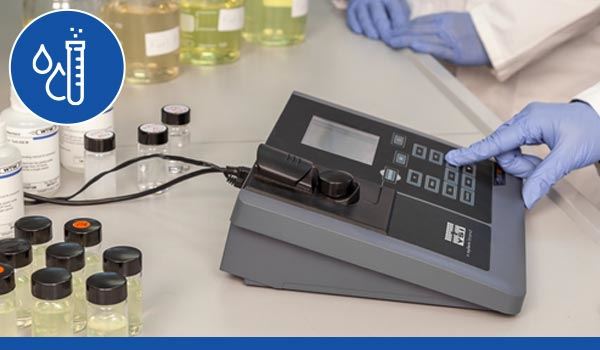
Benchtop meters are ideal for drinking water treatment labs where turbidity values are very low. The YSI Turb750 is compliant with EPA 180.1, as the light source used is a white light tungsten lamp.
It is critically important the cuvette is free of any dust, fingerprints, scratches, or anything else that can interfere with the measurement.
Benchtop meters are intended for use with lower turbidity samples, so they are often used in applications such as drinking water analysis or in beverage production. When used for higher turbidity readings (e.g., greater than 40 NTU), the sample must be diluted according to EPA Method 140.1. This can introduce significant errors in the measurement, so dilution is not recommended unless absolutely necessary.1
Continuous Flow Meters
Rather than placing the sample in a cuvette, a continuous flow meter – commonly called an online turbidimeter – measures turbidity as a constant stream of water flows across the sensor. This type of turbidity meter is most used in drinking water treatment facilities and distribution systems.
As was mentioned in the section Why Measure Turbidity in Drinking Water?, some drinking water facilities are required to measure turbidity at different locations in the facility, such as the combined filter effluent. Online turbidimeters and benchtop meters can be used for this compliance reporting, although it’s essential to select an instrument that follows your required measurement method (e.g., EPA Method 180.1).
The primary advantage of online turbidity meters over benchtop meters is they can continuously monitor for turbidity – there’s no need to collect samples and analyze them in the lab. Collecting real-time data provides a lot of value, as it allows facility managers to respond more quickly to changes in the treatment process.
One disadvantage of online turbidimeters is they are permanently installed at a specific place in the treatment process. If there are five places in the process where turbidity needs to be measured, five different instruments will be required. In contrast, one benchtop meter is all that would be necessary to analyze samples from five locations. It’s important to note that YSI offers benchtop meters such as the Turb750, but we do not offer continuous flow meters.
Online turbidimeters can also be used in the distribution system, where they are often integrated into panel systems that measure other parameters (e.g., pH, chlorine, specific conductance, and temperature).
Submersible Sensors
It is preferred to collect turbidity measurements in situ. Collecting samples and analyzing them later in a lab can cause issues related to biodegradation, growth, settling, precipitation of minerals, and more, although there are methods to help preserve samples.1
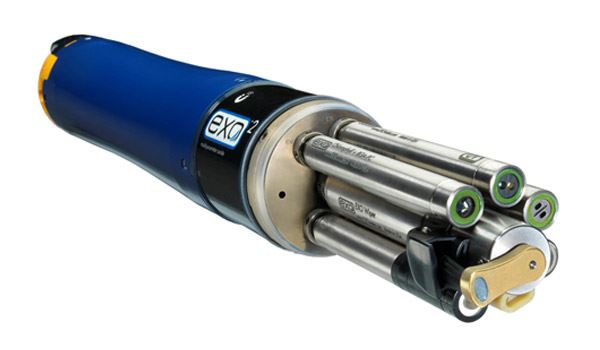
While benchtop meters require the sample to be placed in a cuvette, a submersible turbidity probe can be placed directly in the sample environment. YSI offers turbidity sensors for our EXO (pictured here with various sensors, including turbidity), ProDSS, and ProSwap platforms.
Submersible sensors are portable and can be placed directly in the water (e.g., a stream, an aeration basin in a wastewater treatment facility). Instruments like the YSI ProDSS are designed for spot sampling, while the YSI EXO is intended for continuous, unattended monitoring in many types of environments. We also offer the YSI IQ SensorNet VisoTurb, a turbidity sensor specifically designed for use in a drinking water or wastewater treatment facility.
For some practical guidance on the use of submersible sensors, check out our blog post on Turbidity Measurements: Tips and Precautions.
Want to learn more about turbidity measurement tools? Check out our webinar on How Turbidity Sensors Work!
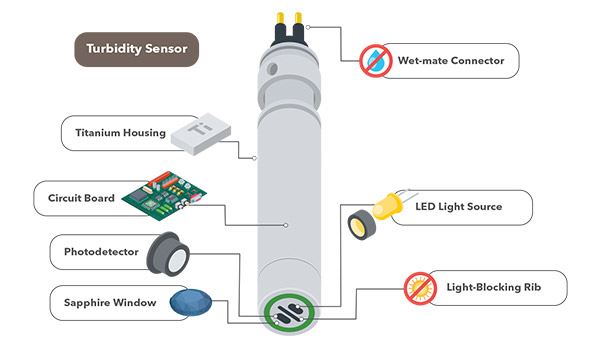
YSI field turbidity sensors transmit light from an infrared LED through the window on each side of the sensor. The light then hits the particles in the water, and portions of the light are reflected back to the sensor. The photodetector is located at a 90-degree angle from the light source and catches the scattered light emitted by the LED.